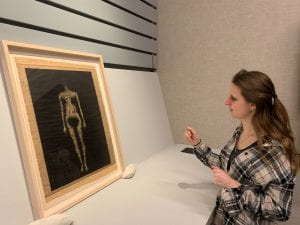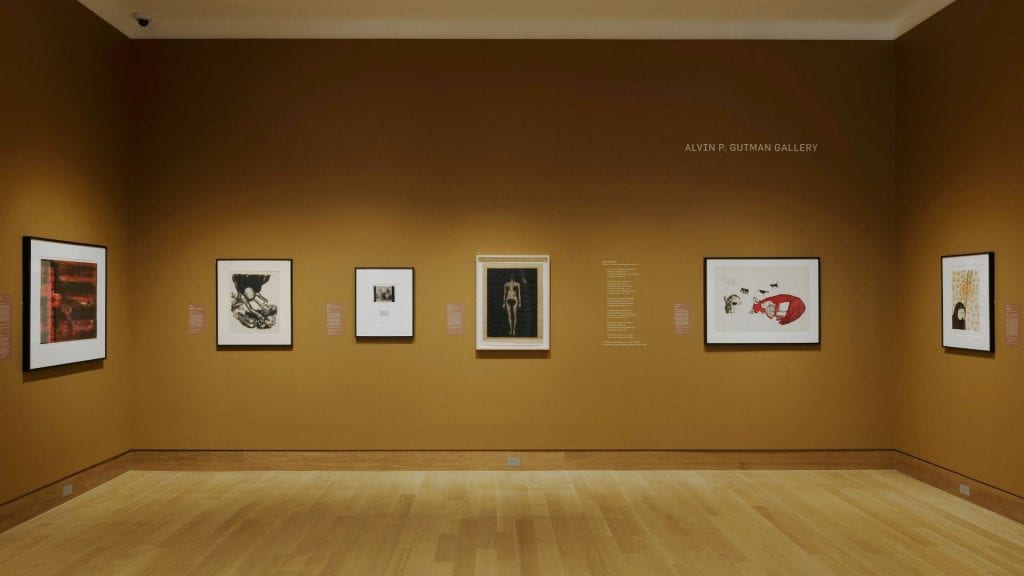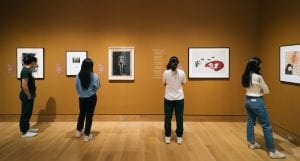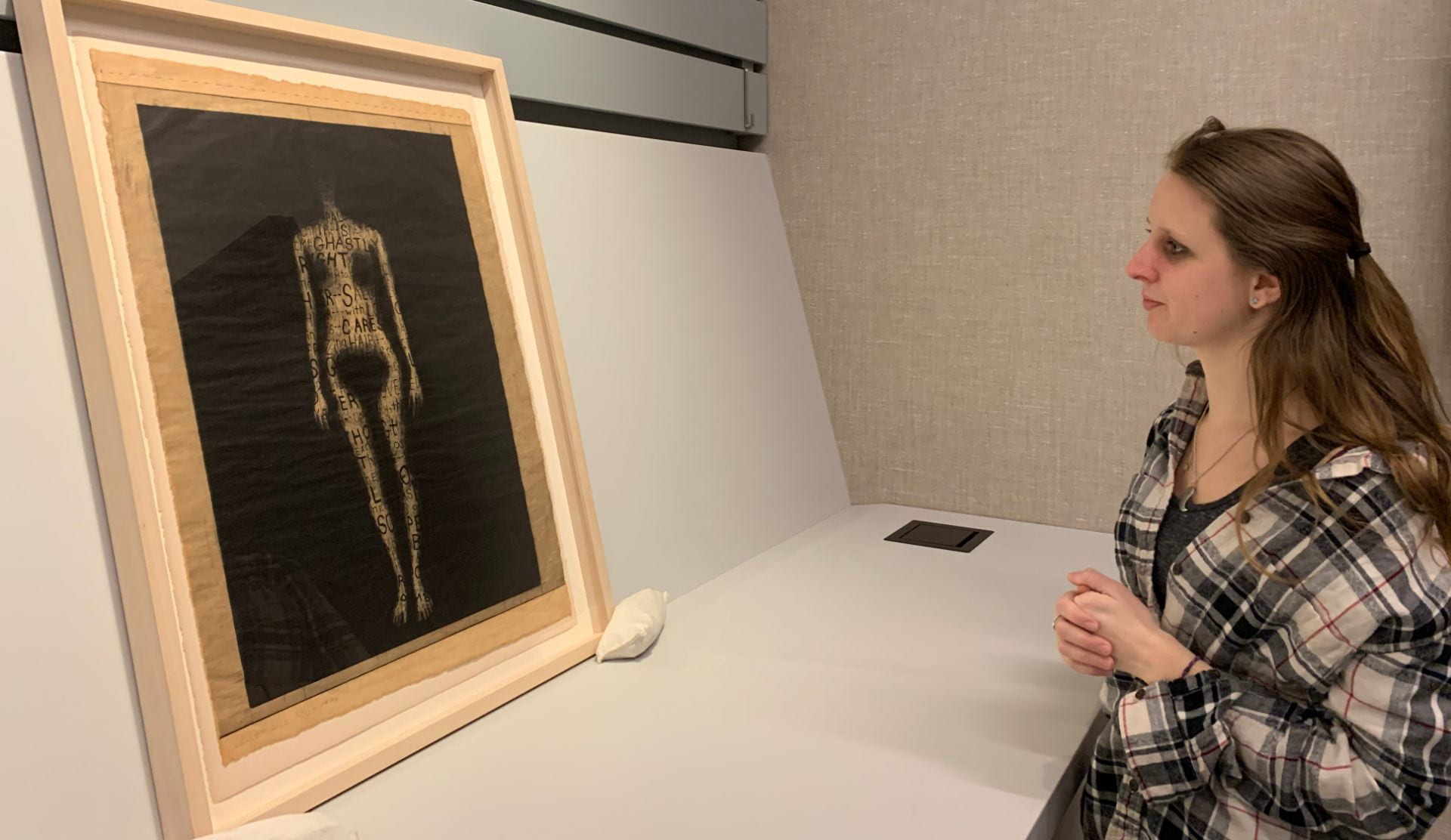Kensington Cochran ’20 was the Hood Museum of Art’s Conroy Intern during the 2019–20 academic year. She was a neuroscience major and art history minor who worked in programming with Hood Associate Curator of Education Neely McNulty. Kensington curated the 100th A Space for Dialogue exhibition, a series of exhibitions curated by Dartmouth students that began in 2002. I had the pleasure of interviewing Kensington about her exhibition, which was on view at the museum March 6–May 16, 2021.
Amelia Kahl (AK): Can you tell me a little bit about your process in choosing your topic for your Space for Dialogue (SFD)?
Kensington Cochran (KC): I have really enjoyed this opportunity because it’s allowed me to combine my two passions at Dartmouth. I came to Dartmouth because I wanted to study neuroscience and art history and it was a place with extraordinary programs in both. So, when I went to curate my show (The Soul Has Bandaged Moments), I knew that I wanted to do a project that combined those two in some way. Focusing on PTSD made sense also in that it ties into so much of my previous work. I’ve done some summer research doing epidemiological PTSD research and then for three years here at Dartmouth I continued some research at the pharmaceutical, biochemical level on PTSD. It was an element that I was always looking for in art because, working on the pharmaceutical side, we’re working on a treatment for this disease. We’ve been working on this for 70 years and have not been able to find it, and art has been able to reverse the physical and biochemical effects of PTSD without us understanding why. So, in this frustrating process of research and trying to find the answer, art already has it, even if we don’t understand it, and it’s so inspiring and heartening for me to be able to look at it from a split perspective. Then this fall my research advisor and mentor passed away, and it took on a whole new meaning for me being able to do work that was inspired by him and his research. I think I look at the show through a different lens–for me, it became more about validating psychological illness as a legitimate disease. It also took on an element of destigmatizing psychological illnesses, so it is still about PTSD, but I think it’s taken on some more cultural elements.
AK: Had you thought about the topic of art and PTSD before you got here? What came first, that focus or the objects?
KC: My interest in neuroscience started out with my younger sister. She has a lot of learning disabilities, so from a young age I was really engaged in her learning process–in learning how she learned differently, why she learned differently, and how I could best help her. Then I just got super excited about the brain. In my sophomore year of high school, I had to write a big sophomore research paper, and I wanted to write my paper on Joseph Beuys. So, I started exploring his work and his process and learned what it meant to be an artist speaking about trauma. During my freshman year in my writing 5 class, I wrote a paper on Anselm Kiefer and his process as well, and so I’ve really been drawn to artists whose work speaks about some sort of process of memorial and psychological healing, and artists who are seeking to do so not only for themselves but for a broader generation.
When I had the opportunity to create a show, I knew I really wanted to focus on PTSD, because that was what my research was on. First, I checked the collection to see if we had any Joseph Beuys, and we have a few, but none pertained to my focus. One of the things I’ve been struggling with, in this process, has been how to not superimpose what I want to see on the work and let it speak for itself, while simultaneously allowing my interpretation of it. That was what was going to happen with the Beuys. So that was tossed out. Then I sat down with Kathy [Hart] and yourself and, as we started to talk about it, the focus really shifted from documenting trauma to describing trauma. The difference I see is a timestamp of what it means to record something in the moment. This includes a lot of photography and a lot of immediate work. I was really interested in what artists were thinking about and how they processed these thoughts years later. I think the Chaim Gross and Otto Dix works were both several years after an experience as they were processing. Also, in the John Walker work, he is processing events years prior. So, what I’m really fascinated in from the neuroscience perspective is what happens after we’re changed–how do we look back, and how do we process? Then you and Kathy inspired me to look at works that are more atypical forms of trauma. I think I came into it looking for my typical–
AK: –thinking about war, for example–
KC: –and sexual violence and those sorts of things. The show has really taken on an element of traumas that are less canonical but equally problematic. So, things like apartheid, the expulsion of Native Americans from their ancestral lands–and that’s an element of the show that was definitely inspired by the collections. The collection’s strength in depicting work, primarily based on the work of Jami [Powell] and Jessica [Hong] to collect work by underrepresented groups, added this element to the show, of speaking about less widely recognized or less canonical traumas that are equally problematic or prevalent.
AK: You have this nice play in your show between this larger cultural trauma and individual trauma and how individuals are thinking about those different kinds of traumas. Can you talk a little about the title of your show and how you arrived at that?

KC: I found one piece. It’s a Lesley Dill piece and the title is Front (The Soul Has Bandaged Moments), and that title just stuck with me. I felt like it articulated what I was trying to say–it speaks to the physicality of psychological illness and injury. But it also has this element of hope in it. It’s a bandaged moment, but there’s a hope of healing, and I wanted that element of hope to stay in the show. I liked the title, then I found out it was actually the title of an Emily Dickinson poem, and luckily we have an Emily Dickinson expert in our English department, so I sat down with Ivy Schweitzer and I learned a lot about Emily Dickinson and particularly this one poem and I spent a lot of time diving into it. So, the poem will go up with the show. It was an amazing opportunity to reach out to experts in the field and have them immediately jump into it. Ivy comes to the Hood for almost every lecture. I think the fact that the Hood has such a prevalent role in so many different departments in our community makes it very easy for me to say, “Oh, I’m doing this thing at the Hood,” and people are like “Oh cool! How can I get involved?” Even the neuroscience department has been really ecstatic about it, so I think that definitely speaks to the work the Hood has done to make themselves available to every single department.
AK: Sometimes when you have a really strong topic it gets hard to find work that fits the theme and hangs together nicely on the wall. Has aesthetics been a consideration for you?
KC: God bless Patrick [Dunfey]. The show actually has a great color scheme going, which wasn’t intentional at first and then I decided to not to include works that didn’t fit the aesthetics of the show. That was an interesting decision, because I realized that there will be a lot of people who will just walk through the gallery and not read my wall text or my brochure. I realized the works needed to stand alone. That can manifest itself in two different ways. One was that a lot of my works are very discrete, they’re layered, you have to engage with them to understand what’s going on. As a result, I ended up picking a Kathe Kollwitz that’s a little bit more obvious in its intent and the reason I wanted to do that is because I wanted people to walk through the room and understand what was going on, even if they just passed through. It was this balance of work that you need to unpack and sift through the layers (not that the Kollwitz doesn’t have layers, but you can get it without engaging too deeply in it), whereas the beauty of, say, the Julie Buffalohead work is that at a first glance it’s kind of comical, it’s light, and then the more you engage, the deeper the conversation goes. So, I wanted the balance of those two types of works.
Going into the design process with Patrick and Sue [Achenbach], we really had a time trying to figure out the right setup for the room. We wanted the space to be inviting, but we’re working with a lot of black and white so we needed a [wall] color that was neutral that wouldn’t take away from the works. We ended up going with brown, and I think we looked at 300 brown wall colors just to find the right warmth, and we wanted a redder tint instead of a greener tint. I didn’t even know brown had so many tints! It was quite the experience and Patrick was very patient. Trying to find the right frames and the right mats was a challenge but a really interesting learning process.

AK: Can you talk about your research and writing process?
KC: It was hard. It’s a type of writing I’ve never had to do before. Well, I think my art history classes actually prepared me well, and a lot of our intern meetings did as well, because in so many of them we practiced looking at objects. The way that my object labels are written is talking about the visual elements of the work, then at the end giving a little bit of history, but it’s hard to get everything you want to say into 100 words. Sometimes in the writing process the more I dove into each object, the more either it seemed to work with the show or it just didn’t. And then the review process was a good experience, helping me develop as a writer as well.
AK: What are the kinds of things that you hope different visitors will get out of your show?
KC: I hope that my show inspires three different conversations. One is understanding and then complexifying the definition of trauma. One of the interesting things about PTSD is that it’s the only psychological illness that’s classified based on the events that trigger it–not by the symptoms with the underlying biochemistry. So, there are a lot of things such as displacement or oppressive environments that don’t have one major trauma but, like in the Berni Searle piece, they speak to more of a daily micro-trauma, that can be considered as causing equivalent types of medical illnesses. So, one conversation is: What are the traumas that are less dramatic, less visible, that are still incredibly problematic and prevalent, and do we contribute to them? In the words that we use, in the norms, and the cultures we set: Are there things that we’re doing that are building up these harmful elements?”
The second conversation is thinking about this disorder as a legitimate illness and a physical disease. A lot of the artists illustrate physical marks of some sort of psychological process. From a neuroscience perspective we have all these biomarkers, we know that there are chemical physical changes and structural changes in our brains. You can see it when you go digging, but it’s a chronic disease that you can’t see from the outside if you look at someone, so it’s harder to understand and it’s harder to be empathetic.
The third is a question about how different artists process healing. Some of them are very personal processes. The Otto Dix is an example of that. Mirriam by Gary Schneider is a piece that talks about a very personal experience of losing his mom and that’s really about personal memorial. But then, Ambreen Butt is really working to process trauma of her generation. She’s creating work that speaks to a contemporary audience trying to process a contemporary issue. So, I think of all of them in a different way, targeting towards different audiences and undergoing different processes, are working through art. That is about the power of art. It’s really me exploring how art is able to solve the problem that scientists have not been able to for 70 years.

AK: You’re a programming intern and this idea of reaching out to audiences and having them think about things is something you’ve been working on in general in your internship. How does this fit in with your internship as a whole?
KC: That’s a good point I think when Maeve [McBride, the other programming intern] and I sat down we were really trying to figure out what audiences haven’t been in the Hood yet because there are student groups who are less likely to put themselves in situations where they might have opportunities to go into the Hood. There are different groups of students that I would hope would come and engage with this show. I think there’s definitely a neuroscience aspect to it and for my peers in that department, I hope that this is a show that they can understand and relate to that’s an entry point for them. There’s going to be a class on Emily Dickinson in the spring and so I’m already working with Ivy to try to get those classes in here and the fact that there can be an element of connection there as well is really exciting for me.
I hope that it fits in the larger narrative that the Hood is trying to put out there. There are groups that have traditionally been underrepresented in museums who can now recognize themselves in the works and the artists that we put front and center. So one of the things that I was thinking about throughout my curatorial experiences is, do we have women artists, do I have minority artists, do I have LGBTQ artists and so 5 out of the 9 are female artists, it’s an international group, it’s an ethnically and racially diverse group. So that was really important to me as well to make sure anyone who came into the Hood into that space, because it is so central, could feel like they were represented, that they would continue to find that sort of representation throughout the gallery.
AK: Is there anything else about your exhibition or the process of putting it together that you would like to talk about or to share?
KC: Honestly, the best part of this experience has been how welcoming and supportive all of the staff has been. For example: I thought to myself, “I think I want to include a work by a Native American artist in the show, but I don’t know how to approach it.” I didn’t know how to say that to Jami Powell without sounding completely ignorant. Jami was so welcoming and she’s really excited about the work that’s going up because she recently collected it and it hasn’t been up yet. She’s invested in my project and has kept in touch about, and that’s been really fabulous. I am cognizant of the fact that this opportunity is rare, and is probably not found anywhere else, so I’m grateful for it. It’s been really such a wonderfully positive experience.
This interview was recorded during the 2019–20 winter term and has been edited for clarity.
Click here to learn more about the exhibition The Soul Has Bandaged Moments (March 6–May 16, 2021).

ABOUT THE INTERVIEWER
Amelia Kahl ’01, the Hood’s Barbara C. and Harvey P. Hood Curator of Academic Programming, is a graduate of Dartmouth and curated the first A Space for Dialogue exhibition in 2001. She is now in charge of the museum’s internship program and assists them in curating their own exhibitions. She also works with faculty and students to study and learn from original works of art. She runs the Bernstein Center for Object Study (BCOS) and partners with Dartmouth faculty to teach in BCOS and the galleries. Her more recent curatorial work includes Resonant Spaces: Sound Art at Dartmouth (2017, co-curated with Spencer Topel) and All Dolled Up (2019). She taught art history at Georgetown University and the University of Maryland and worked at the National Law Enforcement Museum before returning to Dartmouth in the fall of 2010. She has an M.A. in art history from Williams College and is ABD at the University of Maryland.
VIDEO: On April 9, 2021, Kensington Cochran gave her A Space for Dialogue talk virtually (due to the COVID-19 pandemic), watch below:

Comments are closed.